Delhi Republic Day parade
The Delhi Republic Day parade is the largest and most important of the parades marking the Republic Day celebrations in India. The parade takes place every year on 26 January at Rajpath, New Delhi. It is the main attraction of India's Republic Day celebrations, which last for 3 days.
| Delhi Republic Day parade | |
|---|---|
_montage.jpg) | |
| Genre | National patriotic parade |
| Begins | 26 January |
| Ends | 26 January |
| Frequency | Annual |
| Location(s) | New Delhi, India |
| Inaugurated | 1950 |
| Most recent | 2020 |
| Previous event | 26 January 2020 |
| Next event | 26 January 2021 |
| Organised by | Section D, Ministry of Defence[1] |
| Website | republicday |
The first parade was held in 1950, and it has been held every year since.
The parade marches from the Rashtrapati Bhawan along the Rajpath, until the India Gate. It opens with the unfurling of the national flag by the President of India. This is followed by marching from several regiments of the army, navy, and air force, along with their bands. Tableau from various states signifying their culture are displayed. A beating retreat ceremony signifies the end of the parade.
History

The first Republic Day Parade was held on 26 January 1950, during which the President of Indonesia Sukarno was the chief guest. The flypast of that parade included aircraft such as Harvards, Consolidated B-24 Liberators, Dakotas, Hawker Tempest, Spitfires and jet planes comprising a total of more than a hundred aircraft.[2]
Parade
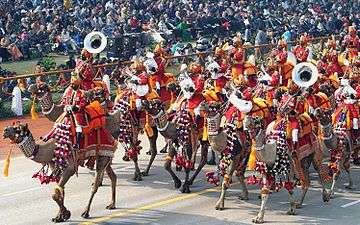
To mark the importance of the Republic Day, every year a grand parade is held in the capital, New Delhi, from the Raisina Hill Rashtrapati Bhavan (the President's residence), along the Rajpath, past India Gate.[3] Prior to its commencement, the Prime Minister lays a floral wreath at the Amar Jawan Jyoti, a memorial to fallen soldiers at the India Gate at one end of Rajpath, which is followed by two minutes silence in the memory of fallen soldiers. It is a solemn reminder of the sacrifice of the martyrs who died for the country in the freedom movement and the succeeding wars for the defence of sovereignty of their country. Thereafter he/she reaches the main dias at Rajpath to join other dignitaries, subsequently the President arrives along with the chief guest of the occasion. They are escorted on horseback by the President's Bodyguard.
First, the president unfurls the National flag, as the National Anthem is played, and a 21-gun salute is given as the PBG renders the National Salute. Next, important awards like the Ashok Chakra and Kirti Chakra are given away by the President. This is followed by the regiments of Armed Forces starting their march past. The President comes forward to award the medals of bravery to the people from the armed forces for their exceptional courage in the field and also the civilians, who have distinguished themselves by their different acts of valour in different situations. Children who receive the National Bravery Award ride past the spectators on colourfully decorated elephants or vehicles.[4]
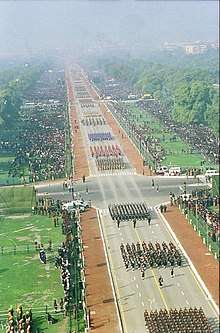
Nine to twelve different regiments of the Indian Army in addition to the Navy, and Air Force with their bands march past in all their finery and official decorations. The President of India who is the Commander-in-Chief of the Indian Armed Forces, takes the salute. Twelve contingents of various para-military forces of India and other civil forces also take part in this parade.[5] One of the unique sights of the parade is the camel mounted Border Security Force contingent, which is the only camel mounted military force in the world. The best N.C.C. cadets, selected from all over the country consider it an honour to participate in this event, as do the school children from various schools in the capital. They spend many days preparing for the event and no expense is spared to see that every detail is taken care of, from their practice for the drills, the essential props and their uniforms. 22 to 30 floats exhibiting the cultures of the various states and union territories of India, including floats of union ministries and state enterprises are in the grand parade, which is broadcast nationwide on television and radio. These moving exhibits depict scenes of activities of people in those states and the music and songs of that particular state accompany each display. Each display brings out the diversity and richness of the culture of India and the whole show lends a festive air to the occasion.[6] Around 1200 schoolchildren present cultural dances as part of the parade.[7] The 2016 Republic Day marked the return of K-9 Dog Squad to the parade after 26 years.[8]
The parade traditionally ends with dare devil motor cycle riding display by motorcycle units of the Armed Forces and civil security services and a flypast by the Indian Air Force jets and helicopters.[9] In 2019, the flypast included aircraft such as Su 30 MKI, Jaguar, Mig 29, C-17 Globemaster and HAL Rudra.[10]
A full dress rehearsal parade is organised on 23 January every year.[11]
Tableaux
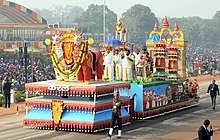
The selection process of the tableaux is conducted by the Ministry of Defence, which involves a number of guidelines. The ministry recommends that tableaux represent a historical event, heritage, culture, development programmes and environment. The tableaux must not carry any logos and should carry some animation and sound.[12]
Proposals are invited from Ministries and departments of the Indian government, and from states and union territories of India within a fixed deadline. The proposals are examined by a committee of experts from arts fields. The examination process involves 2 rounds. The first round provides suggestions for modifications, after evaluating the sketches and designs. The second round evaluates three-dimensional models, after which a final judgement is passed by the committee.[12]
Beating Retreat
.jpg)
The Beating Retreat ceremony officially denotes the end of Republic Day festivities. It is conducted on the evening of 29 January, the third day after the Republic Day. It is performed by the bands of the three wings of the military, the Indian Army, Indian Navy and Indian Air Force. The venue is Raisina Hills and an adjacent square, Vijay Chowk, flanked by the north and south block of the Rashtrapati Bhavan (President's Palace) towards the end of Rajpath.
The Chief Guest of the function is the President of India who arrives escorted by the Presidential Body Guard (PBG), a cavalry unit. When the President arrives, the PBG commander asks the unit to give the National Salute, which is followed by playing of the Indian National Anthem, Jana Gana Mana, by the Army developed the ceremony of display by the massed bands in which Military Bands, Pipe and Drum Bands, Buglers and Trumpeters from various Army Regiments besides bands from the Navy and Air Force take part which play popular tunes like Abide With Me, National Song of India, Vande Mataram, Mahatma Gandhi's favourite hymn Vaishnava Jana To, and Saare Jahan Se Achcha at the end.[13][14][15]
Chief guest

Since 1950, India has been hosting a head of state or government of another country as the state guest of honour for Republic Day celebrations in New Delhi. During 1950–1954, Republic Day celebrations were organised at different venues like Irwin Stadium (National Stadium), Kingsway (Rajpath), Red Fort and Ramlila grounds. It was only starting 1955 when the parade in its present form was organised at Rajpath. The guest country is chosen after a deliberation of strategic, economic and political interests. During the 1950s–1970s, a number of NAM and Eastern Bloc countries were hosted by India. In the post-Cold War era, India has also invited several Western leaders on a state visit during the Republic Day. It is notable that before India fought wars with China and Pakistan, leaders from these countries were invited as state guests for the Republic Day celebrations. The Pakistan Food and Agriculture Minister was the second state guest from that country for Republic Day in 1965, a few days after which the two countries went to a war. Countries which have been invited multiple times include India's neighbours (Bhutan, Sri Lanka and Mauritius), defence allies (Russia/USSR, France and Britain), trade partners (Brazil) and NAM allies (Nigeria, Indonesia and erstwhile Yugoslavia). France has the distinction of being the guest of honour for the maximum (five) number of times followed by four visits from Bhutan and three visits each from Mauritius and USSR/Russia.
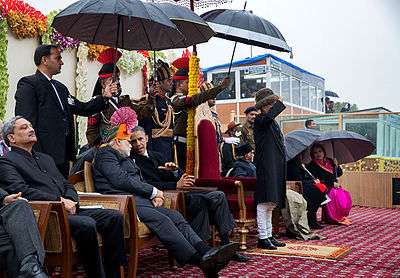
In 2015, the US President Barack Obama was the Chief Guest at Republic Day celebrations, followed by French president François Hollande during the 2016 Republic Day parade. In 2017, Crown Prince Mohammed bin Zayed Al Nahyan from the United Arab Emirates was the Chief Guest of the parade.[16]
Guest contingents
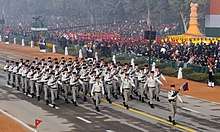
In 2016, French Army soldiers and French Army Band took part in the 67th Republic Day parade. This marked the first time since the beginning of the parade in 1950, that a foreign army contingent marched down the Rajpath during the Republic Day parade.
| Year | Country | Unit |
|---|---|---|
| 2016[71] | France | 35th Infantry Regiment |
| 2017[72] | UAE | United Arab Emirates Presidential Guard |
Awards
Best marching contingents
Best three tableaux
Best tableaux among the Ministries and Department
| Year | Ministry / Department |
|---|---|
| 2020[89] | National Disaster Relief Force and Jal Shakti Mission |
See also
| Wikimedia Commons has media related to Republic Day Parade (India). |
- Republic Day (India)
- Rajpath
- Beating Retreat
- Military parade
- List of diplomatic visits to India
Notes
- 1.^ On each of these occasions, Lady Edwina Mountbatten from United Kingdom was also the official guest for the parade.[22][32]
- 2.^ Duke of Edinburgh Prince Philip also accompanied Queen Elizabeth II during the parade.[29]
- 3.^ Danish Prime Minister attended Republic Day in Madras (Chennai).[90]
- 4.^ No invitations were sent out possibly due to the demise of Prime Minister Lal Bahadur Shastri on 11 January 1966 in Tashkent. The new government headed by Indira Gandhi was sworn on 24 January 1966 (only two days before the Republic Day).[91]
- 5.^ For the first time, the President of India (Sarvepalli Radhakrishnan) could not take the salute at the Republic Day parade due to ill-health.[92] Zahir Shah arrived on 28 January.[93]
- 6.^ Attended only the Beating Retreat[36][37]
References
- "Ceremonials | Department Of Defence". mod.gov.in. Retrieved 21 December 2019.
- "10 things you did not know about Republic Day". India Today. 26 January 2015. Retrieved 16 January 2020.
- "India Celebrates 63rd Republic Day". Efi-news.com. Eastern Fare. 26 January 2012. Archived from the original on 15 May 2012.
- National Bravery Awards-2005 Press Release, Govt. of India.
- "Chap". Mod.nic.in. Archived from the original on 7 March 2011. Retrieved 22 July 2012.
- "Archived copy". Archived from the original on 14 February 2012. Retrieved 20 July 2012.CS1 maint: archived copy as title (link)
- Age Correspondent (15 January 2012). "1,200 schoolkids to take part in R-Day parade". The Asian Age. New Delhi. Archived from the original on 8 January 2018. Retrieved 22 July 2012.
- "Army dogs march down Rajpath on Republic Day after 26 years". 26 January 2016. Retrieved 21 December 2019.
- "Republic Day Celebration - Celebrations - Know India: National Portal of India". knowindia.gov.in. Retrieved 11 January 2020.
- "Curtain Raiser – Republic Day Celebrations 2019". Press Information Bureau. 25 January 2019. Retrieved 11 January 2020.
- "Republic Day full dress rehearsal: Check out grand display of Indian military contingents, array of tanks, fighter planes". The Financial Express. 23 January 2018. Retrieved 11 January 2020.
Every year on January 23, Republic Day full dress rehearsal happens.
- Das, Anjishnu (8 January 2020). "Why only some states get to have Republic Day tableau". The Times of India. Retrieved 11 January 2020.
- "Curtain Raiser – Beating Retreat Ceremony 2011". Ministry of Defence. 28 January 2011.
- "Beating Retreat weaves soul-stirring musical evening". The Times of India. 29 January 2011.
- "Martial music rings down the curtain". The Times of India. 30 January 2011.
- "Abu Dhabi Crown Prince To Be Chief Guest On Republic Day Next Year". Press Trust of India. NDTV. Retrieved 6 January 2017.
- "Republic Day celebrations: President Pranab Mukherjee tweets images from 1950 onwards". The Economic Times. 25 July 2017.
- India, President of (18 January 2015). "King Tribhuvan of Nepal was the guest of honour for the Republic Day in 1951 #26Januarypic.twitter.com/piqaZUKolr".
- "Selected works of Jawaharlal Nehru" (PDF). claudearpi.net.
- https://web.archive.org/web/20050205163551/http://www.dawn.com/2005/01/31/fea.htm
- Rajan, Mannaraswamighala Sreeranga (1964). "India in world affairs, 1954–56". Cite journal requires
|journal=(help) - The Times of India,News Service. (22 January 1956). REPUBLIC DAY IN DELHI. The Times of India (1861-Current) Retrieved from https://search.proquest.com/docview/501661043
- British Pathé (13 April 2014). "Zhukov At India's National Day Aka Zhukov – India (1957)" – via YouTube.
- Deepak, B. R (1 January 2005). India & China, 1904–2004: A century of peace and conflict. ISBN 9788178271125.
- "In India, they have been celebrating Republic Day. After the parade..."
- "Archived copy". Archived from the original on 3 May 2015. Retrieved 2 February 2020.CS1 maint: archived copy as title (link)
- British Pathé (13 April 2014). "Duke Popular Everywhere (1959)" – via YouTube.
- Prasad, Rajendra (1984). Dr. Rajendra Prasad: Correspondence and Select Documents. ISBN 9788170230021.
- "Pandit Jawaharlal Nehru, News Photo, Her Majesty Queen Elizabeth be". Timescontent.com. 26 January 1961. Retrieved 24 January 2014.
- "Archived copy". Archived from the original on 4 March 2016. Retrieved 2 February 2020.CS1 maint: archived copy as title (link)
- Indian Information. 1962.
- British Pathé (13 April 2014). "Republic Celebration (1964)" – via YouTube.
- "Archived copy". Archived from the original on 3 May 2015. Retrieved 2 February 2020.CS1 maint: archived copy as title (link)
- "visit to New Delhi of Mr Kosygin on the occasion of Republic Day – Google zoeken". 2 November 2013. Retrieved 24 January 2014.
- "Asian Recorder". 1969. Cite journal requires
|journal=(help) - "Archived copy". Archived from the original on 3 May 2015. Retrieved 2 February 2020.CS1 maint: archived copy as title (link)
- Link: Indian Newsmagazine. 25 July 1970.
- "India". 1971. Cite journal requires
|journal=(help) - "Foreign Affairs Record". 1972. Cite journal requires
|journal=(help) - Reed, Sir Stanley (1974). "The Times of India Directory and Year Book Including Who's who". Cite journal requires
|journal=(help) - "Indian and Foreign Review". 1973. Cite journal requires
|journal=(help) - Lok Sabha (1975). "Lok Sabha Debates". Cite journal requires
|journal=(help) - "Archived copy". Archived from the original on 17 June 2010. Retrieved 25 January 2020.CS1 maint: archived copy as title (link)
- "The Eastern Economist". 1977. Cite journal requires
|journal=(help) - "Patrick J. Hillery". Clarelibrary.ie. Retrieved 24 January 2014.
- "Bilateral Visits". Hcindia-au.org. Retrieved 24 January 2014.
- "MEA | MEA Links : Indian Missions Abroad". Mealib.nic.in. 23 September 2013. Retrieved 24 January 2014.
- "MEA | MEA Links : Indian Missions Abroad". Mealib.nic.in. 23 September 2013. Retrieved 24 January 2014.
- "MEA | MEA Links : Indian Missions Abroad". Mealib.nic.in. 23 September 2013. Retrieved 24 January 2014.
- "MEA | MEA Links : Indian Missions Abroad". Mealib.nic.in. 23 September 2013. Retrieved 24 January 2014.
- "India Argentina Relations" (PDF). Mea.gov.in. Archived from the original (PDF) on 26 November 2010. Retrieved 24 January 2014.
- "Annual Report 2000–2001" (PDF). Mea.gov.in. Archived from the original (PDF) on 21 December 2010. Retrieved 24 January 2014.
- "meacommunity.org". meacommunity.org. Retrieved 24 January 2014.
- "meacommunity.org". meacommunity.org. Retrieved 24 January 2014.
- "meacommunity.org". meacommunity.org. Retrieved 24 January 2014.
- "Archived copy". Archived from the original on 24 January 2011. Retrieved 25 January 2020.CS1 maint: archived copy as title (link)
- "Choosing R-Day chief guest: Behind the warm welcome, a cold strategy". Indian Express. 25 January 2010. Retrieved 24 January 2014.
- "General South African History timeline" Archived 1 November 2007 at the Wayback Machine sahistory.org.za Accessed on 13 June 2008.
- "Choosing R-Day chief guest: Behind the warm welcome, a cold strategy". Indian Express. 25 January 2010. Retrieved 24 January 2014.
- "Indonesian President next R-Day parade chief guest – Rediff.com India News". News.rediff.com. Retrieved 24 January 2014.
- "Indonesian President next R-Day parade chief guest – Rediff.com India News". Rediff.com. Retrieved 25 January 2012.
- New Delhi, 2 Dec (IANS) (20 January 2012). "Thai PM to be chief guest on India's Republic Day". Deccan Herald. Retrieved 25 January 2012.
- "India invites King of Bhutan as chief guest at Republic Day celebrations". Ibnlive.in.com. 26 January 2013. Retrieved 24 January 2014.
- "India likely to Japanese Prime Minister Shinzo Abe as Republic Day chief guest : India, News – India Today". Indiatoday.intoday.in. Retrieved 24 January 2014.
- "Obama in India joins Modi at Delhi Republic Day parade". BBC News. 26 January 2015 – via www.bbc.com.
- "French President Hollande invited as Republic Day guest". 22 November 2015.
- "Abu Dhabi Crown Prince to be chief guest on Republic Day".
- "India to invite heads of 10 Asean nations for Republic Day celebrations – Times of India".
- "South Africa President Cyril Ramaphosa accepts PM Modi's invite, to be 2019 Republic Day chief guest". www.hindustantimes.com. 1 December 2018.
- "Foreign Secretary Vijay Gokhale: PM had a number of bilateral engagements this morning.Argentina PM is keen to make a visit to India in 2019. PM extended South Africa Pres Cyril Ramaphosa invitation to be chief guest for India's Republic Day in 2019& Ramaphosa accepted.#G20Summitpic.twitter.com/DinFx7zdTV". 1 December 2018.
- "Republic Day 2016: A look at what is special this time". The Indian Express. 25 January 2016. Retrieved 25 January 2016.
- "Republic Day 2017: UAE Soldiers Lead March At Parade On Rajpath". NDTV.com. Retrieved 21 December 2019.
- "Prizes for Republic Day Parade 2005 Participating Contingents". pib.nic.in. 1 February 2005. Retrieved 29 January 2017.
- "Republic Day Parade Awards Announced". pib.nic.in. 2 February 2009. Retrieved 29 January 2017.
- "Dogra, CRPF Best in R-Day Parade, Sangeet Natak Akademibags Tableau Award". pib.nic.in. 30 January 2010. Retrieved 29 January 2017.
- "Republic Day – 2012 Awards". pib.nic.in. 28 January 2017. Retrieved 29 January 2017.
- "IAF, Navy adjudged best marching contingents among Services". The Times of India. 30 January 2013.
- India, Press Trust of (28 January 2014). "Army's Sikh Light Infantry wins best marching contingent award". Business Standard India. Retrieved 21 December 2019 – via Business Standard.
- "Republic Day Parade – 2015 Awards Announced". pib.nic.in. Government of India. 29 January 2015. Retrieved 2 February 2015.
- "Republic Day Parade – 2016 Awards Announced". pib.nic.in. Government of India. 28 January 2016.
- "Republic Day Parade – 2017 Awards announced". pib.nic.in. 28 January 2017. Retrieved 29 January 2017.
- "Maharashtra wins best tableau prize in Republic Day parade". The Hindu. Special Correspondent. 28 January 2018. ISSN 0971-751X. Retrieved 28 January 2018.CS1 maint: others (link)
- Service, Tribune News. "R-Day Parade: Gorkha Brigade wins best marching contingent award". Tribuneindia News Service. Retrieved 21 December 2019.
- ANI (27 January 2020). "IAF adjudged best marching contingent among 3 services at R-Day parade | India News - Times of India". The Times of India. Retrieved 1 February 2020.
- "Republic Day 2020: CISF wins best marching contingent award". Deccan Herald. 28 January 2020. Retrieved 1 February 2020.
- "The Sunday Tribune - Spectrum". www.tribuneindia.com. Retrieved 21 December 2019.
- "Orissa bags Best Tableau award". The Hindu. 29 January 2007. Retrieved 21 December 2019 – via www.thehindu.com.
- "Assam tableau wins first prize at 71st Republic Day parade". www.newsonair.com. Retrieved 29 January 2020.
- "Republic Day: Tableaux of Ministry of Jal Shakti, NDRF named best". www.cityspidey.com. Retrieved 29 January 2020.
- "Danish Premier to Visit India" (4 January 1962). The Times of India
- Pranay Gupte (15 February 2012). Mother India: A Political Biography of Indira Gandhi. ISBN 9780143068266. Retrieved 1 August 2018.
- "Asian Recorder". 25 July 1967 – via Google Books.
- "Asian Almanac". V.T. Sambandan. 25 July 1967 – via Google Books.